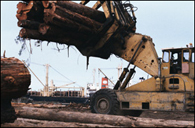|
Classification
Woods are classified as softwood or hardwood, depending on the tree from which
they come. Woods from broad-leaved trees are called hardwoods, and woods from coniferous trees are
called softwoods, regardless of their actual hardness. Thus many softwoods are actually harder than
some of the so-called hardwoods. The hardwoods have long, continuous ducts leading through the trunk;
the softwoods do not have such ducts, and the fluids are transported from cell to cell. Many softwoods
have resin ducts running parallel to the grain, and softwoods in general contain considerable resin,
whereas few hardwoods have any such material in the wood. Hardwood is generally employed for furniture and
high-grade flooring.
Knots are areas of the trunk in which the base of a branch has become embedded in
the body of the wood. When the wood is sawed into planks, the knot becomes evident as a roughly circular
discontinuity or irregularity in the grain structure. Where the branch begins within the tree,
the rings of the knot are continuous with the grain of the wood, producing an intergrown knot;
farther out towards the surface, the grain of the trunk has grown around the branch, producing an
encased knot.
During seasoning , when the shrinkage in a board varies with the direction of the
grain, the knots shrink at a faster rate than the remainder of the wood. An encased knot may thus fall
completely out of the plank, forming a knothole. An intergrown knot cannot fall out, but the wood around
the knot is distorted by the uneven shrinking, and the board may be weakened even more than by the presence
of a knothole. Knots are generally undesirable in timber from the standpoint of appearance, apart from
consideration of their effect on the strength of the wood. In some cases, however, knotty pine and similar
types of timber are desired for panelling interiors, because of the patterns in the grain formed by the knots.
The wood's appearance is one of the most important properties when the wood is being
considered for some interior use such as furniture or panelling. Certain woods, such as walnut, have straight,
parallel graining, which, when combined with dark, attractive colour and great hardness, makes them highly desirable
for veneer. Irregularities of grain may make attractive patterns, or timber may purposely be cut from a crotch
to yield wavy, interlocking patterns. Many veneers are made by peeling a thin layer circumferentially
from around the trunk, so that the knife cuts across the annual ring marks only at considerable distances,
producing the large, irregular patterns typical of many plywoods.
|



